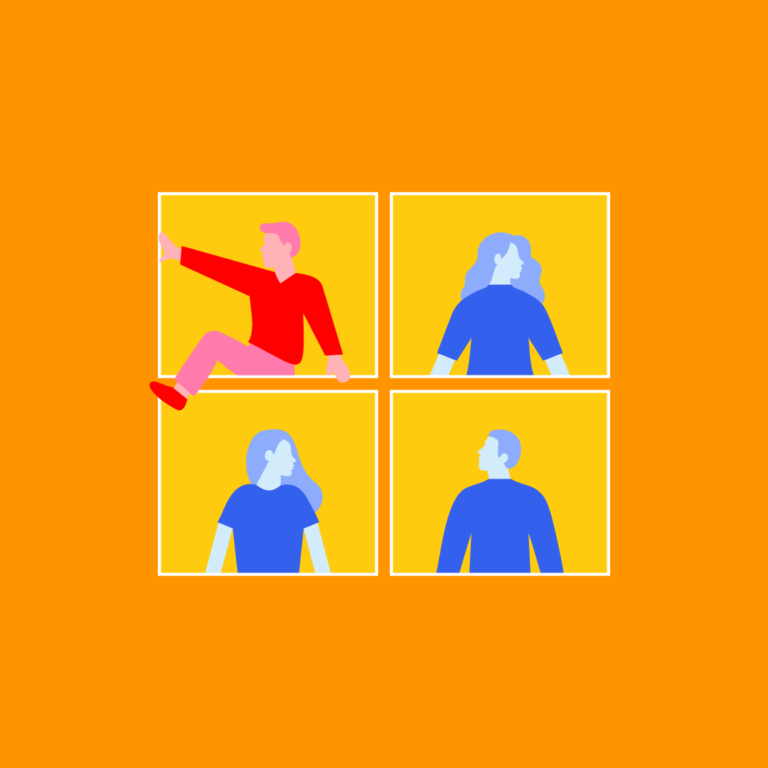December 14, 2020 — Article
Nearly everyone involved in innovation spends their time looking forward to a brighter
future where technology helps us all live happily ever after.
But if we’ve learned anything from the Great Pause of 2020, it’s that life is unpredictable and technology has its limits. Spending millions on COVID-tracing apps looks foolish – people simply won’t use them.
This year has also shone a harsh light on some of the inequities embedded in the systems we have designed and live in. These systems have failed the aged and the vulnerable, causing many to question the accepted order of work and life.
Now, as we move towards a ‘COVID normal’ in Australia, a human-centred approach offers a chance for us all to enter a golden age of innovation, a human-centred renaissance, triggered by a pandemic.
And it’s happened before.
The Black Death was a pandemic that devastated Europe and Asia between 1346 and 1353.
It was a tragedy on a scale so vast that it transformed society and is credited with the emergence of the Renaissance, one of the greatest eras in human history for art, architecture, literature and innovation.
Across Europe, the population dropped by 50 million. The loss of life was so profound it resulted in wide-ranging social, economic, cultural and religious changes.
Economies collapsed as trade ceased due to the fear of spreading the plague. As businesses failed and unemployment rose, there was a complete social breakdown in many areas.
In Italy, which had the most urbanised population at the time, the total population is thought to have fallen by as much as one third. In Florence alone, the population decreased from around 100,000 to 50,000. Contemporary authors reported that people abandoned their work, ignored the sick and dying and instead gave themselves over to wild excess, as they expected to die shortly.
But as the pandemic began to fade, people emerged significantly changed by their experience.
Huge labour shortages meant they now had a chance to organise themselves to reach collective agreements on their wages or the crops would rot in the fields. They began to imagine a post-feudal world.
This phenomenon led to a dramatic shift in the recovering economy, where the shortage of labour forced a burst of innovation as farming moved from labour-intensive operations such as cereal farming to livestock farming. New technology labour-saving machinery was developed.
As wages rose for both urban and agricultural workers, the survivors of the Black Death had a higher standard of living than before the plague.
This eroded feudalism as peasants and farm labourers used their increased wealth to buy themselves free of serfdom.
The rule of the church was challenged as a shortage of monks resulted in unsuitable recruits being quickly ordained, leading both to corruption and a loss of faith. People across Europe began questioning whether it was fair that one’s birth determined their future and whether this really was determined by God – or man.
The church previously had a monopoly on education, but after the Black Death, education became more available, especially in the recovering cities. This was decisive in the development of the Renaissance, with its emphasis on human values and individual emotional experience.
As societies recovered, increased production from improved technology and motivated workers meant large swathes ofNorthern Italy became very wealthy as a more sophisticated economy emerged.
A better-educated populace led to many questioning the old certainties and using reason to make sense of their world.Social mobility became a real opportunity for many previously constrained by a rigid society. Labourers became merchants, merchants became nobles.
This blossoming of education, wealth and mobility allowed the elite, such as the De Medici’s in Florence, to value art and become the patrons of artists including Michelangelo and Leonardo da Vinci.
This potent combination of painters, sculptors, poets, philanthropists, scientists, philosophers, financiers, and architects, combined with technological and educational shifts as well as social mobility, shaped a historical era of innovation that became known as the Renaissance.
Reflective of the fact that the intellectual foundation of the Renaissance was a blend of humanism with a rediscovered Greek philosophy, this new way of thinking and seeing the world manifested itself in the development of perspective in oil painting and the rediscovery of how to make concrete along with contributing to science developing an increased reliance on inductive reasoning based on observation.
As the world opened up again, people began reimagining, reshaping and remixing the world around them, using art, architecture, politics, science and literature.
This changed the way people lived, loved and worked. It changed the way they traded, the cities they designed, the buildings they lived in, as well as the things they made and traded.
What does this mean for us, looking forward to the rest of the ‘20s?
Society is already being reshaped and COVID has accelerated the adoption of technologies. Cities previously celebrated for their cosmopolitan density are now regarded as vectors of infection.
The idea that the diversity of talent drawn to a city would create new forms of value has been shattered by the realisation that you can no longer cram people onto trains, trams or tubes of force them into airless open-plan offices.
It makes little sense when they are simply carrying a laptop in from home to sit at a desk and jump on Zoom or Teams.
So those urban knowledge workers who took pride in their ability to roam freely with a laptop, to work in airports and cafes while on the move, are now picking up those very laptops to roam further afield, leaving the cities and sometimes the state, to work in communities enabled by a patchy NBN, either for progressive local or global firms, firms that recognise talent isn’t constrained by borders.
We’re about to witness a flight from urbanity because even if there is a vaccine, being crammed in with strangers is no longer innocent or an acceptable price to pay just to get to work.
People are starting to discard the obsolete ways of using their time and energy just as those emerging from the Black Death pandemic discarded the feudalism that no longer served the lives they wanted for themselves and their children.
The idea of a 25-year mortgage for a one-bedroom apartment in walking distance of bustling cafes and rooftop bars is no longer tenable for those who’ve spent months confined in lockdown.
We’ll see the rise of the ‘doughnut’ city where all the vibrancy occurs in a ring around the old CBD. Cafes, shops and boutiques will add a unique local flavour to the retail experience in ways online stores cannot match.
A return to a village lifestyle – where you know your neighbours, support local enterprises instead of global supply chains and embrace a less hectic, less commute or car-driven living environment – will create the safety and connectedness people are craving as we enter the rest of the ‘20s.
This will give rise to a golden age where humanity, art, design, ethics, education, philosophy, technology and ecology are combined and remixed to reimagine a new way of life. One focussed on family, friends, community, healthy spaces and, ultimately, a more connected and values-driven society.
The second Renaissance, you might call it.





